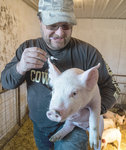Clear, 75° F
It takes a lot to get a pig to the winner’s circle along with happy pictures of 4-H and FFA producers holding ribbons and pigs going for high prices to supporters in the community. It almost …
This item is available in full to subscribers.
The Powell Tribune has expanded its online content. To continue reading, you will need to either log in to your subscriber account, or purchase a subscription.
If you are a current print subscriber, you can set up a free web account by clicking here.
If you already have a web account, but need to reset it, you can do so by clicking here.
If you would like to purchase a subscription click here.
Please log in to continue |
|




It takes a lot to get a pig to the winner’s circle along with happy pictures of 4-H and FFA producers holding ribbons and pigs going for high prices to supporters in the community. It almost sounds glamorous — at least in agricultural circles.
It may have its moments, but behind the scenes there are early mornings, late nights and tons of worry. This year could be the worst in recent memory, according to local hog breeder Travis Smith.
The Powell resident, who is also the founder of Sage Wealth Management, showed up to his Absaroka Street office with his famous smile, but he was carrying a couple overnight bags under his eyes as well. He had spent the previous 12 hours on a night with sub-zero temperatures helping a sow give birth to her litter. He was happy when it warmed up to 16 below zero when he was heading into Powell from his Clark farm.
Unfortunately, all he could do was save the sow. The piglets died during the night, as have many more this year with local producers.
Adding to the bad news, other sows either failed to become pregnant through artificial insemination or only had a couple in the litter, the longtime specialty breeder said. An occasional night up with livestock isn’t where it ends. Smith has seen the price of feed skyrocket along with everything else required to run his pig operation.
Now, the breeder who usually raises up to 65 specialty show piglets a year has less than a third of his average that will be ready to deliver.
“I had bred 18 sows and only two stuck,” Smith said. “My goal is to wean eight pigs per litter, but right now I’m only averaging three and a half pigs a litter.”
Others had the same breeding issues and almost everybody in the region has felt the pain of the price of feed, whether at the feed store or, further down the line, at the meat market. In an attempt to service his longtime customers, Smith traveled to western Iowa to buy two gilts from a supplier.
Iowa raises more pigs than any other state in the nation — by a long shot. In 2022 about 24 million pigs were raised in the Hawkeye State, which works out to be about eight pigs for every person in the state of a little more than 3 million. Iowans know the pork business well and lines from the state often make appearances at Wyoming fairs.
Smith does a lot of business with Iowa pork producers to help breed his show pigs.
“There’s about three of us local breeders. We are all really down this year in our numbers,” Smith said.
The industry as a whole has been suffering from multiple issues, but none less than high sow mortality, said Brad Eckberg, a business analyst at MetaFarms, Inc.
“Sow mortality has been an issue for the past 10 years, continuing to rise every year. In 2021, it did go down slightly, but we are still at a level that continues to increase, which is a very big concern for the industry,” Eckberg told Farm Journal Magazine.
U.S. producers are seeing average sow mortality at approximately 12%. Eckberg says they have over 400 different sow death loss reasons ranging from structural issues to prolapse.
Internationally, African swine fever continues to spread and cause severe production problems in most of Europe, Russia and most of Asia, including China.
And the cost to raise hogs from farrow to finish is up 27%, according to the Iowa State University model. It’s only a guess what that means here in Wyoming, but one of the only benefits to having such a bad year for Smith is that he doesn’t have to buy as much high-priced feed this year.
Of course, there’s a huge difference between raising butcher hogs and show pigs. Feed for show pigs requires special nutrients. Smith helps keep the price down by grinding some of his own ingredients rather than buying it pre-ground, but it is exponentially more expensive than butcher hog chow.
He also had to keep the propane heaters going more often this winter, yet another raw material that has gone up in price. He also is forced to hire part-time help so he can attend to his actual job.
“I kind of a hate to call [raising hogs] a hobby because I spend so much time doing it. You know, when I’m not here at work, that’s what I’m doing,” he said.
Despite the difficulties, Smith still loves breeding for show qualities and working with students. The payoff is knowing the work required to put together the right genetics and rearing shows results with winning pigs. Smith follows the trends, but keeps structure in mind at every turn.
“Structure is always important no matter what the trend is. So we really try to breed for that. But you can get kind of crazy,” he said. “I never chase the extreme trends too much in my breeding, because you can kind of get yourself in a bind.”